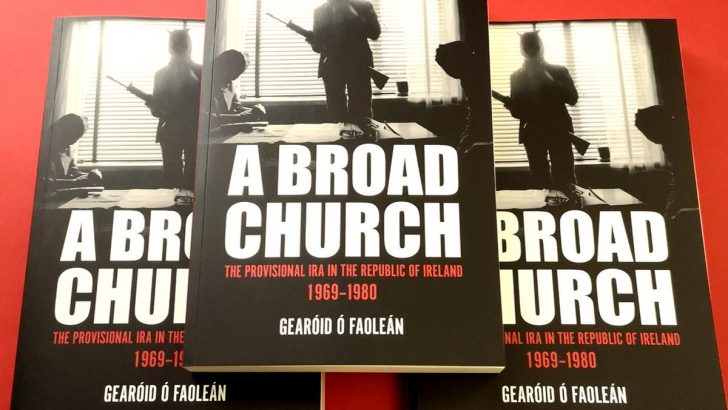A Broad Church: the Provisional IRA in the Republic of Ireland, 1969-1980
Gearóid Ó Faoleán (Merrion Press, €19.95 / £16.99)
Felix M. Larkin
The controversial – and, for some, uncomfortable – argument of this book is that, to quote from it, “there was a sizable though ultimately immeasurable [sic] body of tolerance, if not support, for militant republicanism throughout the Republic of Ireland” during the Troubles – at least in the initial phase of the Troubles, the years covered in this book. The author, Gearóid Ó Faoleán, is a recent PhD graduate of the University of Limerick.
To substantiate his argument, Dr Ó Faoleán points to such manifestations of support as safe houses for Republicans on the run, financial contributions to the Republican cause, acquittals of Republicans in the Courts, a “blind eye” being turned by local communities to IRA training camps in the Republic, an absence of zeal on the part of both the Gardaí and the (legitimate) army in suppressing Republican activity, public demonstrations at IRA funerals and protests against policy blunders like internment and against atrocities like ‘Bloody Sunday’.
Dr Ó Faoleán claims that the Republic of Ireland served “as a hinterland to the conflict” and that the Republic was “dotted from the top of society to the bottom with sympathisers and supporters” of the IRA. He goes so far as to assert that “no political party in the South had a membership or support base that rejected militant republicanism in its entirety”.
He may well be right. We are all aware of “sneaking regarders”, those who sympathise with and/or give support to physical force republicanism without actually participating in its activities.
Evidence
The evidence adduced by Dr Ó Faoleán in his book is, however, largely circumstantial or anecdotal. He relies heavily on Republican sources, especially memoirs and previous studies by scholars who have had close contact with the Republican movement – such as J. Bowyer Bell.
Moreover, while admitting that there were instances of intimidation by the IRA, he too easily rejects that as a factor in the support and tolerance of violent republicanism that he posits.
But is it really not possible to quantify the level of support in the Republic for IRA violence, as Dr Ó Faoleán suggests? His best effort in this regard is to quote from the research of Fr Micháel MacGréil, published in 1977, which showed that 70-80% of the Republic’s population favoured reunification. He implies that this signifies support for the aims, if not always the methods, of the IRA – which, in turn, prompted a high level of tolerance of their activities.
There was, however, another survey in the 1970s which specifically addressed the question of support for the IRA’s campaign of violence. Conducted by Earl Davis and Richard Sinnott, and published by the Economic and Social Research Institute in 1979, it found that about 20% of the Republic’s population were to some degree in support of IRA activities – but only 8% moderately or strongly in support.
Inexplicably, Dr Ó Faoleán does not refer to this survey in his book. It is a grievous omission, as it would have provided solid empirical data to inform his analysis.


